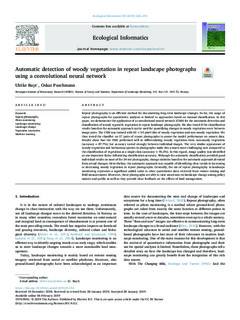| dc.contributor.author | Bayr, Ulrike | |
| dc.contributor.author | Puschmann, Oskar | |
| dc.date.accessioned | 2020-01-13T08:45:40Z | |
| dc.date.available | 2020-01-13T08:45:40Z | |
| dc.date.created | 2019-02-13T10:43:35Z | |
| dc.date.issued | 2019-02-06 | |
| dc.identifier.citation | Ecological Informatics. 2019, 50 220-233. | nb_NO |
| dc.identifier.issn | 1574-9541 | |
| dc.identifier.uri | http://hdl.handle.net/11250/2635849 | |
| dc.description.abstract | Repeat photography is an efficient method for documenting long-term landscape changes. So far, the usage of repeat photographs for quantitative analyses is limited to approaches based on manual classification. In this paper, we demonstrate the application of a convolutional neural network (CNN) for the automatic detection and classification of woody regrowth vegetation in repeat landscape photographs. We also tested if the classification results based on the automatic approach can be used for quantifying changes in woody vegetation cover between image pairs. The CNN was trained with 50 × 50 pixel tiles of woody vegetation and non-woody vegetation. We then tested the classifier on 17 pairs of repeat photographs to assess the model performance on unseen data. Results show that the CNN performed well in differentiating woody vegetation from non-woody vegetation (accuracy = 87.7%), but accuracy varied strongly between individual images. The very similar appearance of woody vegetation and herbaceous species in photographs made this a much more challenging task compared to the classification of vegetation as a single class (accuracy = 95.2%). In this regard, image quality was identified as one important factor influencing classification accuracy. Although the automatic classification provided good individual results on most of the 34 test photographs, change statistics based on the automatic approach deviated from actual changes. Nevertheless, the automatic approach was capable of identifying clear trends in increasing or decreasing woody vegetation in repeat photographs. Generally, the use of repeat photography in landscape monitoring represents a significant added value to other quantitative data retrieved from remote sensing and field measurements. Moreover, these photographs are able to raise awareness on landscape change among policy makers and public as well as they provide clear feedback on the effects of land management. | nb_NO |
| dc.language.iso | eng | nb_NO |
| dc.rights | Navngivelse 4.0 Internasjonal | * |
| dc.rights.uri | http://creativecommons.org/licenses/by/4.0/deed.no | * |
| dc.subject | Repeat photography | nb_NO |
| dc.subject | Photo monitoring | nb_NO |
| dc.subject | Landscape monitoring | nb_NO |
| dc.subject | Landscape change | nb_NO |
| dc.subject | Vegetation succession | nb_NO |
| dc.subject | Machine learning | nb_NO |
| dc.title | Automatic detection of woody vegetation in repeat landscape photographs using a convolutional neural network | nb_NO |
| dc.type | Journal article | nb_NO |
| dc.type | Peer reviewed | nb_NO |
| dc.description.version | publishedVersion | nb_NO |
| dc.rights.holder | © 2019 The Authors. | nb_NO |
| dc.subject.nsi | VDP::Landbruks- og Fiskerifag: 900 | nb_NO |
| dc.source.pagenumber | 220-233 | nb_NO |
| dc.source.volume | 50 | nb_NO |
| dc.source.journal | Ecological Informatics | nb_NO |
| dc.identifier.doi | 10.1016/j.ecoinf.2019.01.012 | |
| dc.identifier.cristin | 1676832 | |
| dc.relation.project | Norges forskningsråd: 194051 | nb_NO |
| cristin.unitcode | 7677,5,0,0 | |
| cristin.unitname | Divisjon for kart og statistikk | |
| cristin.ispublished | true | |
| cristin.fulltext | original | |
| cristin.qualitycode | 1 | |

